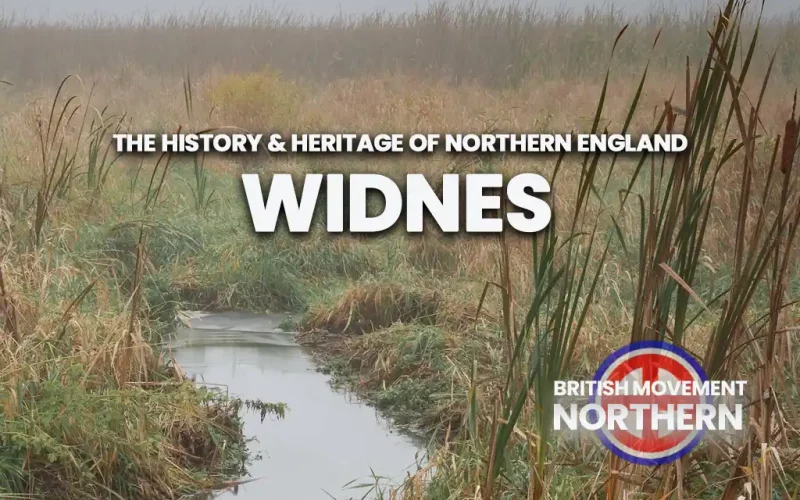Widnes was originally classed as part of Lancashire but in 1974 was transferred to Cheshire.
There is limited Stone Age evidence for settlements in the area, and the later pre-Roman period shows that the marshlands and low-lying areas were under the control of the Setanti tribe but there were no major settlements.
The Romans appear to have largely ignored the area apart from using the crossing points at the Runcorn Gap to ford the River Mersey.
As with many northern towns which grew out of a cluster of medieval villages there are conflicting versions of how the place was named; academics claim that Widnes derives from the Viking period, the settlement was named for its location on a “wide promontory” on the north side of the River Mersey. This was taken from the Danish ‘vid’ (wide) and ‘noese’ (nose) a ‘nose’ of land jutting out from the river bank, a promontory.
In the Anglo-Saxon era the river ‘Mersea’ marked the boundary between the Anglo-Saxon kingdom of Mercia and the Danish/Norse kingdom of Northumbria, and as such the settlement fell within the territory of the Danelaw and was ruled from York (Jorvik) until England was finally unified.
After the Norman Conquest of north-west England, William the Conqueror awarded the Earldom of Lancaster to a loyal Norman nobleman Roger de Poictou, which included most of Lancashire from the Mersey northwards. In 1070 Roger de Poictou created a regional landowner Yorfrid as the first Baron of Widnes. The early manorial records in 1190 refer to the settlement of Widnesse.
The limited medieval records tend to use the name Widnes to include the general area of Widnes moor and Widnes marsh together with the villages of Appleton and Farnworth. After 1310 the whole area passed into the control of the Duchy of Lancaster and few manorial records list the tenants of the estates and farm land of Widnesse under the Castle of Halton.
Throughout the medieval period there was little development in the area other than agriculture and fishing, the River Mersey was unpolluted until the early 19th Century and claimed to provide good catches of salmon and other valuable species of fish.
The first recognisable recording of the township of Widness appeared on early maps in 1577, and recorded limited safe crossing points where the Mersey could be forded at low water.
The Industrial Revolution across the 19th Century and into the early 20th Century permanently changed Widnes, the town expanded and became a centre of the UK chemicals industry. From 1830 onwards the industrial developments began.
So rapid was the expansion of the chemical industry in the town during the Victorian era that Widnes gained a bad reputation for polluted waterways and piles of industrial waste. In 1888, Widnes was described in the pages of the ‘Daily Post’ as “the dirtiest, ugliest, most depressing town in England”.
As Widnes was a relatively small town compared to other much larger industrial centres, this was pretty damning even by Victorian standards.
The population census figures for Widnes tell their own story; in 1802 the population of Widnes was 1,063, in 1901 it was 28,580, by 1991 it was 55,708 and at the 2011 census it was 61,464.
For all the industrial developments, Widnes can still be classed as a White Town, the most recent population data shows that the population is 97.6 % White, mostly White British, with an Asian minority population 0.8%, a black population 0.2%, mixed race 1.0% and 0.1% other (Arab or Chinese etc).
The British Movement would love to receive articles for possible inclusion on this site from members and supporters across the North of England. Please remember that we have to operate within the laws of this country – we will not include any content that is against the current laws of the United Kingdom. News reports should be topical and be relevant to the regions covered by this website.












